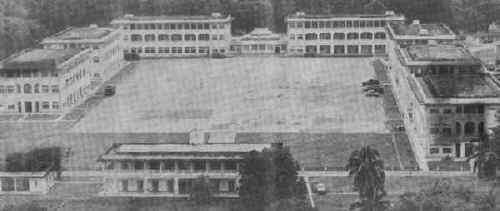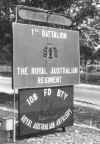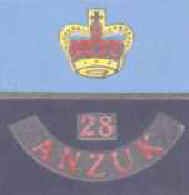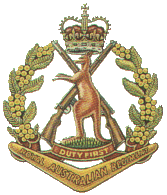 |
| Category:
Conflicts/Malaya |

|
|
|
|
|
|
Selarang Barracks, Changi,
Singapore |
| In 1969 Selarang Barracks
became the home for most of the Australian Army units that would go to
help make up ANZUK. This
force replaced the old 28th Commonwealth Infantry Brigade that had been
based in Terendak Barracks, Malacca, Malaya ( later Malaysia) for a long
period following the Malayan Emergency and through the time of Confrontation
with Indonesia. It was made up of Australian,
New
Zealand
and United
Kingdom
troops, hence ANZUK. First
Battalion The Royal Australian Regiment (1 RAR) was stationed at Selarang 1969/70. At that time
ANZUK Force had not officially started but 28 ANZUK Brigade was in existence. This
page is to present the photos taken at the time. |
|

|
|
Selarang Barracks,
Changi, Singapore, 1968. Set on 400 acres it was the HQ for 1RAR and
it's supporting units. |
|

|
Headquarters
Building. In the main picture this is seen,
from the rear, in the centre foreground. In 1969/70 this was HQ for the entire Australian
Component (a reinforced Battalion) made up of First Battalion The Royal
Australian Regiment (1RAR), 108 Field Battery Royal Regiment of
Australian Artillery (RAA). 2 Field Troop Royal Australian
Engineers (RAE), 182 Independent Recce Flight, 32 Australian Dental
Unit, the Australian Army Force Band and other light aid detachments had
offices, hangars and workshops adjacent.
The lower photo is the same building in 2002. It is
now HQ for 9th Division of the Singapore Armed Forces (SAF)
|
 |
 |
Nee
Soon Barracks. Other Australian Units were
based at Nee Soon barracks as was Brigade HQ. Australians were in
the minority there as the Brits and Kiwis were based there as well. Aussie
Units included 11 Field Ambulance, 1 Division Supply and Transport
Workshops and 28 Brigade Provost Unit. Note the similarity of
architecture between Nee Soon and Selarang. Note also that Nee Soon had
two Regimental Parade Grounds (Punjab Square and Meerut Square). |
 |
Barracks
1, 2 & 3 at Selarang. Looking from the
HQ Building they were on the left. The nearest was 108 Fd Bty RAA and
then Admin Coy and A Coy barracks. On the main photo above they are on
the left. The smaller building
on the right hand side ( centre rear of the main photo) is the Other
Ranks Mess Hall (kitchen and dining room) |
 |
Selarang
Barracks ORs quarters. This shows
the amount of space allocated to each man in the Australian lines.
Australians were lodged 6 men to a room. The Brits were 12 to a room.
Approx 800 men were at Selarang in 1969. There were 15,000 there in 1942
during the "Selarang Incident" |
 |
Barracks
4, 5, & 6 at Selarang. These
barracks were home to B Coy (left of photo) C, and D Companies. Support
Company (Building 7 is out of shot to the right). On the main photo they are on the right. |
 |
HQ
building for 108 Field Battery RAA. This
building was the operational office for the artillery unit that
supported 1RAR. |
 |
Regimental
Aid Post (RAP). The medical centre
for persons on base. staffed by an RAAMC Doctor, a Sergeant from the Royal
Australian Army Medial Corps (RAAMC) and several Stretcher Bearers (now
called Combat Medics) who were trained riflemen with a sideline in
matters medical |
 |
The
NAAFI Store.
NAAFI (Navy,
Army
Air Force Institute)
was/is an
organisation that provides shops and canteens for the British Armed
Forces. The Australian equivalent was ASCO (the Australian
Services Canteens Organisation). As
NAAFI was so well established in
Malaysia/Singapore ASCO decided to leave it to them. This building was a self service grocery and convenience
store inside the barracks perimeter. |
 |
Married
Quarters. Most married soldiers
and their families lived off base due to a shortage of married quarters.
Those that lived on base had quarters like these. |
 |
The
Main Gate. Selarang Barracks is on
the main road from Singapore City to Changi Village. It is 7 miles to the
City and 2 miles to Changi Village. Changi is on the eastern end of
Singapore and is both a township and a locality name. It is also the
site of the International Airport. |
|
Major buildings not
photographed. Officers Mess, Sergeants Mess, ORs Canteen. |
|
History
of Selarang Barracks
Pre-World
War II
When British surveyor, General Gillman, first inspected Changi district
in 1927, the vicinity consisted of little more than mangrove swamp and
virgin forest, with the exception of a police station at the mouth of
Changi River and a small Malay village nearby. However, the Changi
Peninsula's strategic importance in controlling the eastern approaches
to the Johor Straits soon became apparent to the Colonial Government.
Therefore, within the next 15 years, extensive development was done to
transform Changi into a formidable military base.
Work on Selarang Barracks began in 1936 and the whole complex was
completed in 1938. A battalion of Gordon Highlanders immediately
occupied Selarang Barracks.
World War II
During the Japanese occupation from February 1942 to August 1945,
Selarang Barracks became a prisoner-of-war camp. Initially housing
Australian POWs, Selarang Barracks came into prominence as a result of a
remarkable chain of events in September 1942, known as the
"Selarang Barracks Square Incident''. Four young soldiers (Cpl.
Rodney Breavington, Pte. Victor Gale, Pte. Harold Waters and Pte. Eric
Fletcher) who tried to escape from prison were recaptured.
As a result, the Japanese wanted the POWs to sign a document promising
not to escape under any circumstances. This was against the Geneva
Convention on POWs which permitted opportunities of escape. When the
POWs refused, the Japanese crammed 15,400 men, including those brought
over from Changi, into the barracks which was meant for only 1,200 men.
The square was crowded with makeshift tents as men spilled out from the
buildings.
There were no toilet facilities although each barracks building had
about four to six toilets, which were flushed from small cisterns on the
roofs. The Japanese, however, cut the water off and these toilets could
not be used. The Japanese only allowed one tap to be used and prisoners
had to line up in the early hours of the morning and that queue would go
on all day. Each man was allowed one quart of water for drinking,
washing and everything else.
To force the POWs to sign, the Japanese had the four soldiers shot on
Changi beach on 2 September 1942 with senior POW officers watching. With
the desperate food and sanitary conditions getting worse daily, and the
threat of an epidemic breaking out in the overcrowded camp, the men were
persuaded by their officers to sign the document to prevent any more
unnecessary deaths. The signing took place on 5 September and after that
the prisoners returned to their original barracks.
Post-World War II
At the end of WWII and the return of colonial rule to Singapore in 1945,
Selarang Barracks once again became the home of the colonial
peace-keeping forces. This arrangement continued until 1 October 1971,
when the 6th Battalion Royal Australian Regiment (6 RAR) officially handed over the
camp to the SAF. 42 SAR became the camp's tenants until March 1984 when
the 9th Division took over Selarang. |
|
Changing Commitments 1971-77
In 1967, the United Kingdom had announced that half of its forces in
Malaysia and Singapore would be withdrawn by 1971 and the remainder within
five years. In 1971 a new defence agreement, the Five Power Defence
Arrangement (FDPA), was negotiated to provide for consultation regarding a
response to any threats or external attacks on Malaysia and Singapore.
This involved the formation of an ANZUK force, the ANZUK Brigade Group
which was based in Singapore. This force included an RAR battalion with a
supporting field battery (originally, in 1955, components of the BCFESR 28
Commonwealth Brigade) and other elements. The ANZUK force was disbanded in
1975 when first the Australian and then the British Governments decided to
withdraw their ground forces.
With the election in December 1972 of a new Labor government under
Gough Whitlam, the completion of the withdrawal from Vietnam and the
ending of the National Service scheme were immediately effected . The new
Australian defence and military policy was based on a withdrawal from the
previous policy of 'forward defence' and the lack of a credible short-term
threat to Australia's security.
A further significant change in defence commitments occurred in 1976 when
the last SEATO exercise was held and the organisation formally disbanded
in June 1977.
In 1972, following a major review, the Government agreed to a complete
reorganisation of the Army on functional lines. This involved disbanding
the geographical commands and creating Field Force, Logistic and Training
Commands, leaving smaller geographically-based military districts with
primarily supporting administrative roles.
In anticipation of Papua New Guinea independence, the Papua New Guinea
Defence Force (PNGDF) was established in 1973, based largely on the
battalions of the Pacific Islands Regiment. With independence, an
Australian Defence Advisory Group (ADAG), primarily manned by the
Australian Army, was located at Port Moresby to assist in the development
of the PNGDF.
In 1974, the report of the Committee of Inquiry into the Citizen
Military Forces (The Millar Report) was published. In the years following
the re-formation of the Citizen Military Forces (CMF) in 1948, it had
suffered a number of setbacks through the impact on volunteers of the two
National Service schemes and the Pentropic Reorganisation. The Millar
Committee had been commissioned in 1973 as a result of perceptions of lack
of role, poor morale and organisational problems. A change in title to
'Army Reserve', major reorganisation affecting the status of the two
infantry divisions, amalgamation of understrength units, improved
conditions of service and adoption of the 'One Army' concept were among
many changes recommended and implemented.
Because of a history of confusion and duplication of effort in the
provision of defence force aid to the civil community in time of major
disasters, in 1974 the Whitlam Government created the Natural Disasters
Organisation (NDO) within the Department of Defence. The NDO was to
coordinate defence efforts in supporting the civil defence organisations
of the states and territories. The first major Army commitment under the
new organisation was to the relief of Darwin following the devastation of
Cyclone 'Tracy' in December 1974. Other major commitments have included
the 'Ash Wednesday' bushfires of 1983 and the Newcastle earthquake in
1989. Less spectacular assistance is usually provided for ‘normal’
disasters such as flood relief, locust plagues, and bushfires, together
with the provision of emergency shelter, evacuation of medical emergency
cases and making dangerous ordnance safe.
In 1975 the Defence Force Reorganisation Act was passed. It abolished
the three service boards, designating the three service chiefs of staff as
the professional heads of their services with full powers of command under
higher defence direction. The position of Chief of the Defence Force Staff
(CDFS) became the Chief of the Defence Force (CDF) in 1986 and was created
to command the Defence Force and act as the principal military adviser to
the Government. Meanwhile the reorganisation of the Defence group of
departments (Defence, Navy, Army, Air Force and Supply), combining all
five within an enlarged Department of Defence, was completed.
|
|













